David Suzuki's Blog, page 28
September 1, 2016
In diversity, there is strength
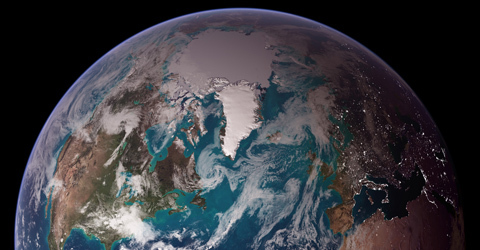
(Credit: NASA Goddard Space Flight Center via Flickr)
It's been shocking to watch news of the Brexit vote in Britain, Donald Trump's promise to build a wall between Mexico and the U.S. and the ongoing threats and violence against ethnic minorities in many parts of the world. I'm not a political or social scientist, but my training as a biologist gives me some insight.
When I began my career as a scientist, geneticists were starting to analyze the molecular properties of single genes within a species. When we started looking at highly evolved species such as fruit flies, we thought we would find that their genes had been honed through selection over time, so they would be relatively homogeneous within single species. Examining one kind of protein controlled by a specific gene, we expected to find them all pretty much the same. Instead, we learned there was a great deal of heterogeneity, or diversity. A gene specifying a protein could exist in a number of different states.
This is now called "genetic polymorphism" and is considered to be the very measure of a species' health. Inbreeding or reduction of a species to a small number reduces genetic polymorphism and exposes harmful genes, thereby rendering the species more susceptible to sudden change. In other words, genetic polymorphism confers resilience by providing greater possibilities as conditions shift.
Within ecosystems, species diversity provides greater flexibility to adjust to disturbances. Around the planet, ecosystem diversity has enabled life to flourish under different conditions. Like nested Russian dolls, life seems to have been built on diversity within diversity of genes, species and ecosystems.
Over time, conditions on the planet have not remained static. In response to change, life has had to adapt or disappear. The sun is 30 per cent warmer today than it was when life arose four billion years ago. The atmosphere changed from oxygen-free to oxygen-rich after plants evolved. Continents have moved, collided and pulled apart. Oceans have filled and emptied. Mountains have risen up and worn down. Life spread from the oceans to land and into the air. Ice ages have punctuated warm periods. And all the while, life fluctuated and flourished because of the resilience conferred by diversity.
Human beings have added another level of diversity: culture. Cultural diversity has enabled our species to survive and flourish in regions as different as deserts and Arctic tundra, wetlands and steaming tropics, prairies and mountains.
Monoculture -- the spreading of a single gene, species, ecosystem or idea -- runs counter to the biological principle that diversity confers resilience. It creates vulnerability to change, especially sudden change. As a biologist, I believe we should encourage, spread, maintain and celebrate diversity. The drive to restrict immigration of people with different beliefs and the hostility to people of different ethnic, religious or cultural background are extremely dangerous.
In Canada, the apparently well-meant exhortation for Indigenous people to abandon their remote communities reflects the failure to see the enormous value offered by a sense of connection to place and accumulated cultural knowledge. As newcomers to these lands over the past five centuries, many of us lack the deep ties to place that are critical in a time of vast ecological change and degradation.
The United States is built on colonization and destruction of the diverse cultures that existed on this continent before European contact. That nation has evolved on the assumption that it's a "melting pot," where newcomers shed their identity of origin and blend with the dominant culture as Americans.
Similarly, Canada developed with a policy of growth while maintaining immigration dominated by a British majority. Under Pierre Trudeau's government, Canada deliberately embraced the notion of the "cultural mosaic," valuing diversity within society. I believe this is an exciting experiment in nation-building based on fundamental scientific truths. The challenge is to ensure that we can celebrate our diversity while recognizing our place as a country without elevating some groups above others.
From the microscopic level of genes to large-scale biological systems, and from natural ecosystems to human communities, diversity brings strength and resilience in the face of ever-changing conditions. In today's world, that's more important than ever. We must resist attempts to reduce diversity in all its forms.
Hey! Want more DSF? Join David Suzuki on Facebook

Is Ontario's surplus electricity a problem?
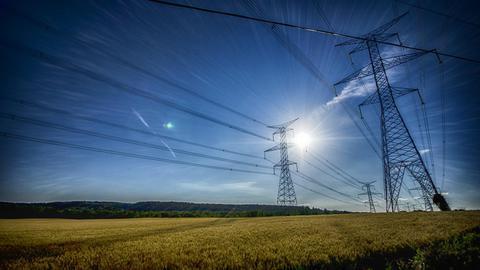
(Credit: Douglas M Paine via Flickr)
Supply and demand in an electricity system must always be the same. When you produce too much, you have to figure out how to curtail production or export the excess. In Ontario we often curtail nuclear from the Bruce plant. To do this, we simply send the heat from the nuclear reactor into Lake Huron, but we don't save any nuclear fuel. We curtail wind. And we pay generators to not produce. In 2014, Ontario paid them $200 million to not produce. Sometimes we pay neighbours to take it. Or we sell it to them real cheap -- under two cents/kWh. Ontario exported 12 per cent of what it produced last year, and sold much of it at very low prices.
How did it get this way? It is actually a good news story. Ontario has reduced its demand for electricity by 12 per cent since 2005. Demand has been going down throughout the western world. Appliances are more efficient. Variable speed motors and fans are more efficient. Efficient LED lighting is exploding in popularity. Conservation programs have worked. GDP is up. Population is up. But we are using less juice.
Ontario's inflexible nuclear plants continue to operate. We also added wind, solar and gas to replace coal. And we had an unanticipated and ongoing decrease in demand. So we have surplus power.
Importantly, greenhouse gas emissions from Ontario's electricity sector are very low. Only 10 per cent of Ontario's electricity comes from a fossil fuel, gas.
What if we turned this surplus electricity "problem" into an opportunity? Instead of paying to curtail electricity production, or exporting power at low prices, what if instead we used this surplus to heat our buildings and drive our plug-in vehicles. Instead of using oil, propane or natural gas to provide heat, we could use low-emission electricity to run ultra-efficient geothermal heat pumps. Instead of using gasoline or diesel, we could use electricity to drive our vehicles.
We can also produce hydrogen by hydrolysis. Hydrogen can be mixed up to a few per cent with natural gas in our pipelines with no change in consumer appliances. Our surplus electricity could thereby reduce our demand for natural gas. This is being done in Europe now.
But we need to create this new demand for electricity to drive our cars, heat our homes and produce hydrogen. It won't just happen. How do marketers approach this? They have a good old-fashioned sale -- 50 per cent off. If you buy an electric car, or install a geothermal heating system, or make hydrogen from hydrolysis, then you get a discount on part of your power. After all, it's better to sell at half price to new customers than to pay someone not to produce. Better to sell at half price than to export at 80 per cent off.
What would be the result of switching to electricity for building heat, or for driving, or for hydrogen production? We would have lower emissions and higher electricity demand using up surplus that we are wasting today.
The second U.S. president, John Adams, has been quoted as saying, "Every problem is an opportunity in disguise."
The opportunity is staring us in the face.
Hey! Want more DSF? Join David Suzuki on Facebook

August 30, 2016
How to make dry shampoo (that's also body, baby and shoe powder)
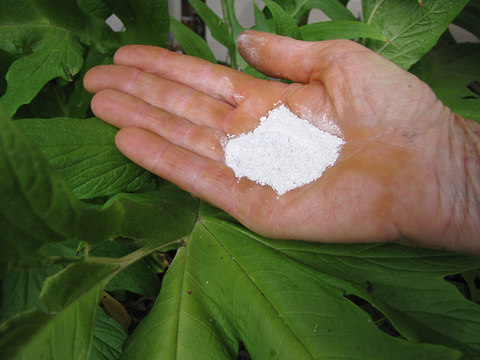
Arrowroot powder is fine in texture and white in colour and comes from the manioc plant. (Credit: Forest and Kim Starr via Flickr)
Before you could buy dry shampoo, many people used baby powder. But that contains talc and fragrance...
Parfum (a.k.a. fragrance) is one of our Dirty Dozen ingredients to avoid. It's any mixture of smelly ingredients used in a variety of cosmetics. And they stink!
Some fragrance ingredients trigger allergies and asthma.
Some link to cancer and neurotoxicity.
Some harm fish and other wildlife.
Talc is a made of magnesium, silicon, and oxygen. Once it also contained asbestos! It has two human health concerns:
Respiratory toxicity: The reason you DON'T sprinkle baby powder on infants. Physicians sounded an alarm over inhalation risks and recommend against it.
Cancer: A Missouri jury awarded US$72 million in damages to the family of a woman who died of ovarian cancer after decades of using talc-based powder.
The good news? You don't need either!
Dry shampoo recipe
This recipe has at least four uses. It absorbs excess moisture, prevents chaffing and soothes skin. (For external use only. Avoid inhaling.)
Time needed: five minutes
Shelf life: approximately six months
62.5 ml (1/4 cup) cornstarch
62.5 ml (1/4 cup) arrowroot powder
15 ml (1 Tbsp) white clay (found at health food stores)
Optional: 6 drops of essential oils
For dry shampoo: Try lavender, rosemary or ylang ylang essential oils. Brunettes can add 5 ml (1 tsp) fair trade organic cocoa powder.
For baby powder: Add 3 drops of sweet orange, 2 drops of ylang ylang and 1 drop of geranium essential oil.
For athletic gear: Try antibacterial and antifungal essential oils such as tea tree, lemongrass or eucalyptus.
Mix ingredients together. Store in an air-tight container.
How to apply:
Dry shampoo: If you're keen to shampoo less, apply mixture to oily parts of your scalp with an old makeup brush. Comb through.
Body powder: Sprinkle between toes and under arms.
For babies: Ingredients are non-toxic and food grade. To avoid risk of inhalation, dab on babies, do not sprinkle. Note: Cloth diapers made from organic cotton, hemp or wool allow the skin to breathe. This reduces the need for creams, salves, etc. Plastic disposables are more likely to cause diaper rash.
Athletic gear: Add to running shoes, hockey gloves, etc.
What will you try this recipe? Share your review in the comments below.
Sincerely,
Lindsay Coulter, a fellow Queen of Green
Hey! Want more DSF? Join David Suzuki on Facebook

August 29, 2016
2016aug29 dev signup form for ok
Hey! Want more DSF? Join David Suzuki on Facebook

August 26, 2016
South Australia shows how clean energy is done
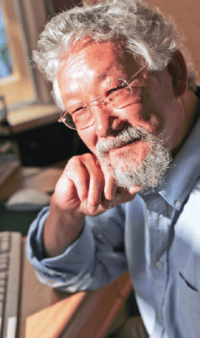
Visitors to Australia are often drawn to Sydney and Melbourne or the fabulous beaches of Queensland's Gold Coast. I've always had a soft spot for Adelaide in South Australia, a city built on a human scale.
When I first visited in 1993, I met Mike Rann, a young aboriginal affairs minister in South Australia's Labor government, who later became party leader and then state premier in 2002. In 2003, he outlined ambitious plans to address climate change by moving South Australia into renewable energy.
He also introduced me to the Youth Conservation Corps. Young people in this program are trained to restore land overgrazed by sheep or cattle, plant trees and make wildlife inventories. Rann surprised me by dedicating 45 hectares of reforestation land as Suzuki Forest. I was impressed by the passion and eagerness of the young people, many of them street kids. They believed in what they were doing and it provided a small income to get them off the streets.
My Adelaide visit that year ended at the World of Music and Dance festival, or WOMAD. It's a marvelous annual event where I met Uncle Lewis O'Brien, a Kaurna elder who honoured me with the name Kaurna Mayu (mountain of a man).
Last March, I returned as a guest of WOMADelaide. To my delight, Uncle Lewis once again welcomed us to his country. I also met Ian Hunter, South Australia's environment minister, who boasted of his state's progress in renewable
energy. South Australia gets 40 per cent of its electricity from solar and wind and hopes to reach 50 to 60 per cent within a few years. From my hotel room, I looked down on a factory roof covered in rows of solar panels, which are now mounted on one of every four houses. I also returned to Suzuki Forest and was delighted at the variety and size of plants and trees, and the birds that now flourish among them.
Despite the impressive work in South Australia, most of the country is caught between the terrible reality of climate change -- droughts, massive fires and dying reefs -- and continued pressure to serve the economy by relying on fossil fuels, including recently approving the world's largest coal mine.
Australia -- like much of the world -- is in the throes of deciding whether to act seriously to reduce the threat of climate change. South Australia shows that many opportunities exist to do so.
Hey! Want more DSF? Join David Suzuki on Facebook

How to make dish soap
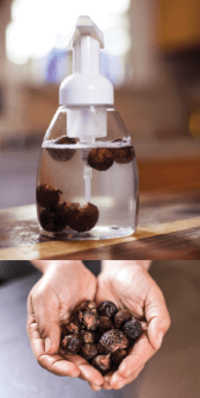
Soap nuts are biodegradable and free of scents. (Credit: Shannon Ruth Dionne Photography)
This recipe has no fragrance or toxic ingredients, takes a minute to make and works.
Ingredients
* One handful soap nuts (a.k.a. soapberries)
* 1 L (4 cups) tap water
Directions
Add ingredients to a glass jar with a tight-fitting lid or to a pump soap dispenser. Shake before each use. When it bubbles, pour about 125 ml (½ cup) of the solution into your sink. Refill the jar with water. Use this solution until the soap nuts stop making suds or smell bad. Then throw them in the compost and start a new batch.
You may need to alter ingredient ratios. Success will depend on water hardness and dish grime.
HOW DO SOAP NUTS WORK?
Soap nut shells contain large amounts of natural surfactants called saponins. Surfactants lower a liquid's surface tension, so they make good detergents or foaming agents.
Find soap nuts in many health food stores, organic grocers or online. They're biodegradable, certified organic and many companies pay fair wages to local producers (e.g., in India).
Take soap nuts on your next camping trip and use the solution to wash fruits and veggies!
Hey! Want more DSF? Join David Suzuki on Facebook

Putting your money where your mouth is
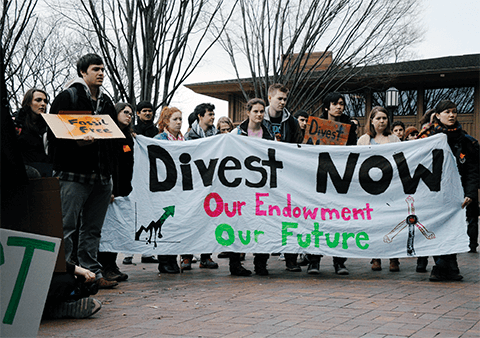
(Credit: James Ennis/Flickr)
In three short years, the fossil-free movement has grown from a few U.S. colleges to a global movement. By moving money away from fossil fuels and putting it into renewable energy and energy efficiency, we are closer than ever to a planet fuelled by sun, wind and water.
Money is flowing into renewables and clean technology is growing. We already know that fossil fuels are bad for the planet, but now they're a bad investment as well.
The David Suzuki Foundation was an early leader in moving investments out of fossil fuels. We've moved our endowment fund investments into industries such as green energy, sustainable farming and clean water.
One of the companies that is helping us manage our sustainable investments is Genus Capital Management. Find out about Genus at www.genusfossilfree.com or contact them directly at 1-844-660-5122 or fossilfree@genuscap.com
Hey! Want more DSF? Join David Suzuki on Facebook

You're helping people wake up to Canada's toxic shame

Grassy Narrows residents still suffer from mercury poisoning, decades after a chemical dump. (Credit: Leadnow/Flickr)
Where were you in '62?
In 1962, biologist Rachel Carson published Silent Spring. It explained how toxic chemicals like DDT concentrate up the food chain. (Some say Carson's book launched the environmental movement. David Suzuki says it changed his life.)
That same year, a pulp and paper mill began dumping untreated waste into the Wabigoon River system, upstream from First Nations communities, including Grassy Narrows. Until 1970, more than 9,000 kilograms of mercury poured into the watershed.
Mercury is a potent neurotoxin. Many people in Grassy Narrows suffer from numbness, loss of co-ordination, trembling and other problems. Some can't walk. Many are in wheelchairs. Mercury poisoning is also linked to developmental problems in children, which persist into adulthood.
Japanese scientists have studied Grassy Narrows residents for decades. They say the people are suffering from Minamata disease, caused by mercury poisoning. Yet the Ontario government refuses to clean up the watershed.
The Ontario government has long known that cleaning up Grassy Narrows is possible but has chosen not to act. More than 50 years later, scientists still find dangerous mercury concentrations in area lakes.
Thanks to you, people know that the water and fish Grassy Narrows residents depend on can become safe to drink and eat again. More than 10,000 have written to Ontario Premier Kathleen Wynne urging her act.
If you haven't already, please stand with Grassy Narrows by signing the letter here: action2.davidsuzuki.org/grassynarrows.
Hey! Want more DSF? Join David Suzuki on Facebook

Thanks to you, belugas and their babies are now protected by law
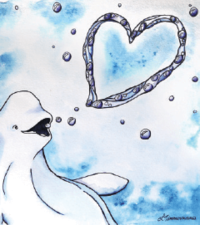
(Credit: Art by Laura Timmermans)
The beluga is the only whale found in Quebec's mighty St. Lawrence year-round. Once, thousands of the snow white whales lived in the river. Today, there are fewer than 900.
You helped inspire more than 23,000 people to demand protection for the threatened whales. In April, TransCanada Corporation scrapped its plan to build an oil port in Cacouna. That project, to move oil sands bitumen, would have been right in the heart of everything the belugas need to live.
Now the St. Lawrence estuary belugas are finally protected by law. In May, the federal government banned anyone from destroying the whales' critical habitat. This is a major milestone -- and you helped make it happen!
Beluga whales use sound to communicate, navigate, find food and mate. But they can't say thank you, so we're doing it for them!
Hey! Want more DSF? Join David Suzuki on Facebook

You're helping stop Site C
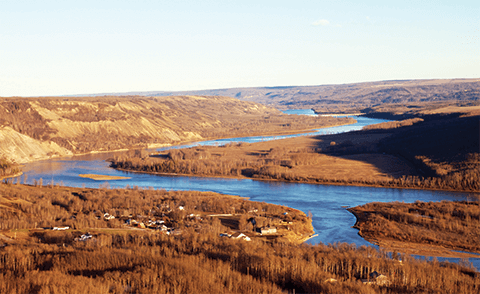
Preparation for Site C has already altered the Peace Valley. (Credit: Tuchodl/Flickr)
Canadians are lining up to oppose B.C.'s Site C dam.
The flood area for the mega-dam includes prime farmland and supports abundant wildlife. The dam will sit on Treaty 8 First Nations traditional territory. And they're pushing back in court. But BC Hydro is still clear-cutting old-growth trees along the Peace River.
Large projects like Site C threaten Indigenous people's way of life. Canada should not move ahead with energy projects that violate human rights. Thanks to you, 10,000 people used our website to ask the prime minister not to support the project.
Hey! Want more DSF? Join David Suzuki on Facebook

David Suzuki's Blog
- David Suzuki's profile
- 247 followers



